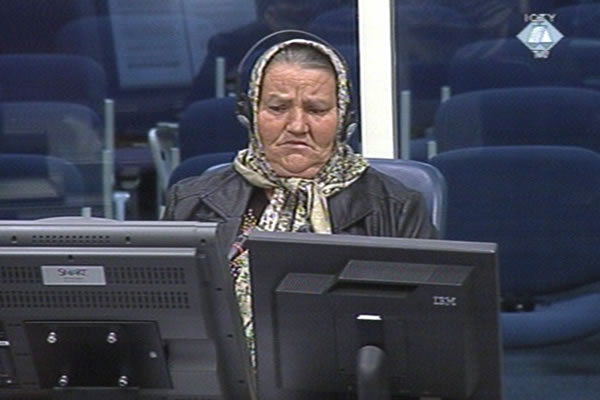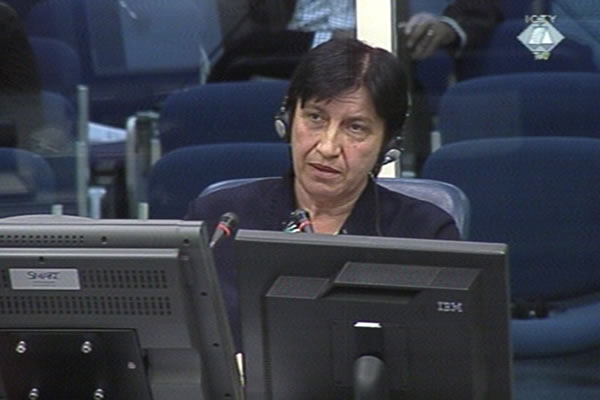Home
MOTHERS FROM SREBRENICA TELL THEIR STORY
Saliha Osmanovic and Mirsada Malagic described how they lost their closest family after Srebrenica fell. They both saw the accused Ratko Mladic in Srebrenica. Osmanovic and Malagic were deported from the Serb territory together with thousands of other women and children
 Saliha Osmanovic, witness at the Ratko Mladic trial
Saliha Osmanovic, witness at the Ratko Mladic trial The prosecution's case at the trial of General Ratko Mladic continued with the evidence of two women from Srebrenica. In July 1995, the two witnesses suffered the same fate: they left their homes before the Serb troops arrived in the enclave, sought shelter in Potocari, and were deported from the territory under the Serb control. They both lost their closest family in the genocide. Both witnesses contend that they saw Ratko Mladic on 12 July 1995 when he spoke to the refugees gathered in Potocari.
Saliha Osmanovic spent the war in Srebrenica with her husband and two sons. Osmanovic's youngest son was 17 years old when he was killed on 6 July 1995 in an artillery attack on the town. As Mladic's troops got closer to Srebrenica the exodus from the town began. The women, children and elderly sought shelter in the UN compound in Potocari. Men of military age took to the woods hoping to reach the liberated territory. On 11 July 1995, the witness went to Potocari with her father-in-law. The witness's elder son, 18-year old Nermin, and her husband Ramo headed out through the woods towards Tuzla. Nermin and Ramo were captured by the Serbs en route and executed. Their remains were identified in 2009. In the footage taken on 13 July 1995, Ramo Osmanovic is seen calling his son Nermin and other Bosniaks to surrender; he had been ordered to do that by the Serb soldiers.
Mirsada Malagic also lost her husband and two sons in the Srebrenica genocide. She was deported from Srebrenica with her youngest son. Malagic said that they 'didn't even say goodbye properly' when they parted. Two days later Malagic arrived in Zivinice. There she waited for days hoping to see her family again. Malagic's two brothers managed to get through to the liberated territory. Malagic's sons and husband didn't. In her testimony at the trial of the former Drina Corps commander Radislav Krstic in 2000 she described how she felt as she waited in vain, Malagic compared herself with the sculpture with a 'lost look in her eyes' on the beach in Scheveningen. The sculpture symbolizes the women who waited for their families who went out to see to fish. Today Malagic said she felt the same way when she looked at the 'empty woods' and waited for her husband and sons to come. The hope finally died when their remains were discovered, identified and buried a few years ago, the witness recounted.
Both witness said that they saw Ratko Mladic in Potocari on two different occasions as he addressed the refugees. Saliha Osmanovic claimed that Mladic told them to 'throw away everything you have because the Serb army will come now'. Mirsada Malagic recalled Mladic's attempt to calm down the crowd and convince them that nothing bad would happen to them. After that men were separated form women and children, Malagic recounted. Among them was Malagic's 70-year old father-in-law who was later killed.
In the cross-examination, Mladic's defense focused on the military status of the members of the Osmanovic and Malagic family who were killed. Both witnesses replied that their husbands served in the BH Army in Srebrenica from time to time. However, none of their sons had anything to do with the army, both women said.
Ratko Mladic’s trial continues on Tuesday. The prosecution alleges he is one of the masterminds in the four joint criminal enterprises in BH, including the genocide in Srebrenica.
Photos
Linked Reports
- Case : Mladic
- 2013-05-14 WITNESS: THERE WAS HATE, BUT NO DESIRE FOR REVENGE
- 2013-05-10 HOW TO ‘SECURE’ DETAINEES
- 2013-05-09 ORAHOVAC KILLING FIELDS
- 2013-05-21 WHO PLANNED AND CARRIED OUT SREBRENICA OPERATION?
- 2013-05-22 KARADZIC’S DIRECTIVE WAS USED AS SANCTION DESIGNED TO ACHIEVE ‘CHANGE OF REGIME’
- 2013-05-23 DIGGING MASS GRAVES

